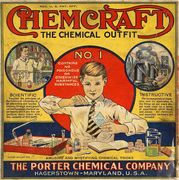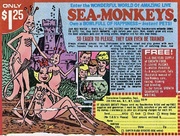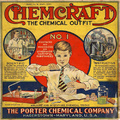The lone frontiersman, the rebellious explorer: These archetypal characters appear as frequently in the far reaches of outer-space as in the American West, from “Star Wars” to “Stagecoach,” on Planet Vulcan or the Oregon Trail. Today, toys, comic books, and even movie posters representing these figures are equally familiar. But which holds more power for kids and adults alike? Are spacemen our true heroes, or would we rather have a cowboy riding to our rescue, to protect us from tobacco-spitting bad guys and slimy tentacled aliens?
“In an all-out battle, cowboys beat spacemen, at least in our hearts.”
Toys encapsulating the spirit of the Wild West have been popular at least since the Civil War, but it wasn’t until the advent of radio that children became cowboy fanatics. During the 1940s, serials like Gene Autry’s “Melody Ranch” and “The Roy Rogers Show” made these honorable frontiersmen, exemplars of a courageous, individualist mentality, into bona-fide stars.
Just as cowboy fever hit its peak in the 1940s and ’50s, tensions between the U.S. and the Soviet Union turned the country’s attention to space. The military potential of space travel and rocket weaponry created a cultural fervor for all things relating to life beyond our atmosphere. Movie studios churned out sci-fi films almost as fast as Westerns, cars were adorned with space-age tail fins, and space toys took kids to the moon, and beyond. Instead of fighting Native Americans or train-robbing outlaws, space heroes battled universes full of alien enemies.
Patricia Hogan, a curator of toys and dolls at The National Museum of Play at The Strong, notes that these aliens weren’t really as foreign as we might like to think. “In the ’20s, when the notion of the robot became popular, we thought aliens were these robotic machines that would overcome humans. In the ’60s, when people started worrying about the environment, ecology, and nature, aliens started to look more like insects.” Looking at over a century of space toys, Hogan recognizes that “our idea of an alien is based more on ourselves, of what we fear and worry about.”
By the 1960s, companies like LEGO and Marx produced outer-space playsets inspired by comic series like Flash Gordon and Buck Rogers alongside Western standards like the Alamo and Fort Apache. Suddenly, there were two tough characters in town, each too big for his britches—the cowboy and the astronaut. Though their worlds were light years apart, these two fought head to head when it came to the attention of kids, and their moneyed parental units. Although manufacturers never placed the characters in opposite corners of the ring, at least not officially, in the world of play, every kid had his favorite and knew who would win when the day came for the Lone Ranger and Major Matt Mason to face off.

A stoic showdown between cowboy and astronaut PEZ dispensers from the 1970s. Image courtesy Karen Freed.
Classic toy collectors tend to agree: Regardless of the newfangled gadgetry and futuristic advantages of spacemen, in an all-out battle, cowboys win hands down, at least in our hearts. Part of that appeal was the cowboy’s code of honor, says Mike Nichols, son of the co-founder of Nichols Industries, Inc., a major producer of cap guns and Western-themed toys. Nichols explains that “space toys and video games put almost all cap gun companies out of business – coupled with the demise of the Old West Heroes. My Uncle Talley once remarked, ‘I always thought it was the quality of our cap guns that was selling them, without realizing that it was really Roy Rogers.’”
Yes, space toys superseded Western ones in terms of production, sales, and general popularity, but we still pine for the rugged cowboy. Perhaps because cowboys are drawn from actual characters in our cultural history, we still see a bit of ourselves in them.
Toy and doll designer Stefanie Eskander says she relates to the cowboy character, particularly Woody from Disney’s “Toy Story” series, because he’s a more fully developed hero. “He’s loyal, kind, adventurous, smart, enterprising, clever, a born leader, humble, old-fashioned,” she says. Similarly, PEZ collector Karen Freed allows that although there are desirable rarities among astronaut PEZ dispensers, in a pinch, the cowboys and sheriffs of PEZ’s Wild West would certainly conquer their outer-space counterparts.

Tom Whalen’s poster designs for “Toy Story” and “Cowboys & Aliens,” two films that exemplify the clash of sci-fi and Western genres.
Tom Whalen, who creates limited-edition movie posters for Mondo, has worked with a wide variety of Western and sci-fi imagery. As Whalen sees it, “the cowboy represents the American spirit in its purest form,” which means they are perfectly capable of dealing with aliens, who stand for “a fear of the unknown.” That’s perhaps why cowboys thrived in the 1950s, when the stereotypes of Indians, aliens, and our Communist enemies became conflated: Each group was essentially unfamiliar, and thus viewed as intolerable by the wider American psyche.
Tyler Stout, another Mondo artist, whose trio of “Star Wars” posters are avidly collected, concurs. “As a genre, you’d have to classify cowboys as good hardworking Americans, and aliens as representing ‘the other.’ Since the other is usually the opposite of us, if we’re the good guys, aliens tend to be the bad guys.” Stout also believes that cowboys were more powerful symbols in the past because, “people knew they actually existed and liked to imagine living that life of adventure. But now that there are reality shows about cowboys, and there’s a lot less mystique about them, aliens might be a bit more in vogue. Since they are unknown, they give people something to dream about.”

This ’50s-era “Man-From-Mars Totem Head” cereal premium conflated Native American imagery with space aliens.
During the 1950s, companies explicitly mixed the symbolism of these different enemy groups. Patricia Hogan recalls a fascinating cereal premium made by Ralston Purina called the “Man-From-Mars Totem Head.” As Hogan explains, “it’s a cardboard head that you assemble and use as a mask, and it looks like a Northwest Indian totem figure. Clearly they assigned that likeness, that Northwest Indian likeness, to Martians.”
Over the next few decades, comic books became one of the first places where these genres were formally merged. In July of 1952, “Cowboy Western Comics” changed its name to “Space Western Comics,” placing its star cowboy, Spurs Jackson, in a futuristic setting, complete with ranch hands that doubled as space vigilantes. Though Space Western was a smaller publication, even titles like “Superman” got in on the action, with its 1977 issue in which our hero battles a villainous space cowboy called the Terra Man. By the time the first “Star Wars” film was released, viewers were comfortable with the idea of robots and space explorers thrown into a desolate desert landscape or a lawless saloon like the Cantina.

Left, a Malcolm Reynolds action figure made for the recent “Firefly” series and right, a Lone Ranger action figure from the 1970s.
In our post-modern pop culture landscape, cowboys and spacemen frequently meet in a common environment. According to prop designer Randy Eriksen, who helped give the steampunk space-Western television show “Firefly” its distinctive look, the appeal of that cult classic wasn’t necessarily its hybrid setting, but rather how human nature is explored in a multitude of situations. People are drawn to shows like Firefly, he says, primarily because, “the writing is brilliant. It’s not about space or science or cowboys, it’s about human interaction that just happens to involve space cowboys.” Eriksen believes that this focus on people and “how they think and act and interact” is what really fascinates us. “Maybe it’s a little more ‘down-to-earth’ because they’re cowboys, which we all know from history, rather than being like characters on ‘Star Trek,’ where everything is all new, cool, shiny, blinky, and laser beams.” For Eriksen, such gee-gaws distract from the characters.
And then there’s “Toy Story,” the most well-known cowboy-spaceman matchup. In that modern-day fable, Woody and Buzz start as antagonists for their boy’s affection, but ultimately need each other and their distinct strengths to save the day. Woody’s folksy charm aside, Hogan believes that most people actually “relate better to the astronaut, because we like to see ourselves as the noble character going off to explore new realms or galaxies.” She finds that kids connect well with space toys because they allow them to create their own stories and narratives, rather than replay the cowboy legends that have already been written. Hogan is confident that “we will always have aliens, whereas cowboys have come and gone.” Despite our nostalgia for a more wholesome Western past, space toys still hold the promise of a brighter future, that final frontier which will forever tantalize kids and adults alike.



 Attack of the Vintage Toy Robots! Justin Pinchot on Japan’s Coolest Postwar Export
Attack of the Vintage Toy Robots! Justin Pinchot on Japan’s Coolest Postwar Export
 Cyanide, Uranium, and Ammonium Nitrate: When Kids Really Had Fun With Science
Cyanide, Uranium, and Ammonium Nitrate: When Kids Really Had Fun With Science Attack of the Vintage Toy Robots! Justin Pinchot on Japan’s Coolest Postwar Export
Attack of the Vintage Toy Robots! Justin Pinchot on Japan’s Coolest Postwar Export Sea-Monkeys and X-Ray Spex: Collecting the Bizarre Stuff Sold in the Back of Comic Books
Sea-Monkeys and X-Ray Spex: Collecting the Bizarre Stuff Sold in the Back of Comic Books ToysToys are vehicles for the imagination, the physical objects children manipu…
ToysToys are vehicles for the imagination, the physical objects children manipu… Mari Tepper: Laying it on the Line
Mari Tepper: Laying it on the Line Nice Ice: Valerie Hammond on the Genteel Charm of Vintage Canadian Costume Jewelry
Nice Ice: Valerie Hammond on the Genteel Charm of Vintage Canadian Costume Jewelry How Jim Heimann Got Crazy for California Architecture
How Jim Heimann Got Crazy for California Architecture Modernist Man: Jock Peters May Be the Most Influential Architect You've Never Heard Of
Modernist Man: Jock Peters May Be the Most Influential Architect You've Never Heard Of Meet Cute: Were Kokeshi Dolls the Models for Hello Kitty, Pokemon, and Be@rbrick?
Meet Cute: Were Kokeshi Dolls the Models for Hello Kitty, Pokemon, and Be@rbrick? When the King of Comedy Posters Set His Surreal Sights on the World of Rock 'n' Roll
When the King of Comedy Posters Set His Surreal Sights on the World of Rock 'n' Roll How One Artist Makes New Art From Old Coloring Books and Found Photos
How One Artist Makes New Art From Old Coloring Books and Found Photos Say Cheese! How Bad Photography Has Changed Our Definition of Good Pictures
Say Cheese! How Bad Photography Has Changed Our Definition of Good Pictures Middle Earthenware: One Family's Quest to Reclaim Its Place in British Pottery History
Middle Earthenware: One Family's Quest to Reclaim Its Place in British Pottery History Fancy Fowl: How an Evil Sea Captain and a Beloved Queen Made the World Crave KFC
Fancy Fowl: How an Evil Sea Captain and a Beloved Queen Made the World Crave KFC
So that’s what the “Man from Mars Totem Head” looks like in color. I’ve seen the original commercial from SPACE PATROL, where it’s promoted by the show’s announcer (and future game show host), Jack Narz.
I love the comics of The Lone Ranger, I do remember the times of my childhood with my brothers
year 1955.
Yuko
Cowboys rule!